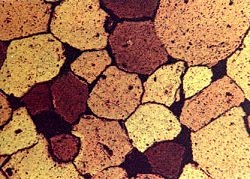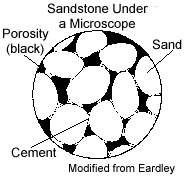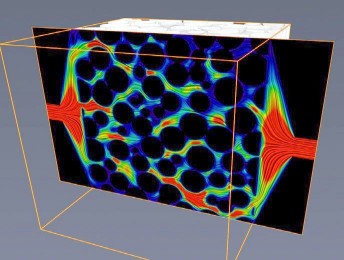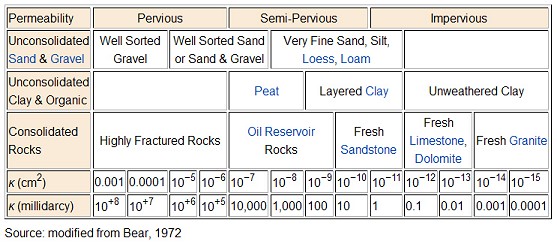Porosity and Permeability
Porosity and permeability are related properties of any rock or loose sediment. Most oil and gas has been produced from sandstones (though that is changing, as the country becomes more dependent on shale oil and gas formations). Sandstones often have high porosity, and are usually “high perm” too. Porosity and permeability are absolutely necessary to make a productive oil or gas well. The petroleum geologist must stay focused on the porosity and permeability of the prospective reservoir.
- Porosity consists of the tiny spaces in the rock that hold the oil or gas.
- Permeability is a characteristic that allows the oil and gas to flow through the rock.
You need both porosity and permeability to make a producing oil or gas formation.
Porosity
Porosity of a rock is a measure of its ability to hold a fluid. Mathematically, porosity is the open space in a rock divided by the total rock volume (solid + space or holes). Porosity is normally expressed as a pecentage of the total rock which is taken up by pore space. For example, a sandstone may have 8% porosity. This means 92 percent is solid rock, and 8 percent is open space containing oil, gas, or water. Eight percent is about the minimum porosity that is required to make a decent oil well, though many poorer (and often non-economic) wells are completed with less porosity. And, as stated above, oil and gas from shale formations has changed the picture in the 21st century.
Even though sandstone is hard, and appears very solid, it is really very much like a sponge (a very hard, incompressible sponge). Between the grains of sand, enough space exists to trap fluids like oil or natural gas! The holes in sandstone are called porosity (from the word “porous”).

Sandstone under microscope
Here is a very thin slice (thinner than a human hair) of actual sandstone as seen through a microscope. The larger brown and yellow pieces are grains of “quartz,” an extremely common mineral. Between the grains, you can see the porosity (shown as black) in the rock.
If you take a piece of sandstone and pour water on it, you will see the water is absorbed right into the rock. The water is soaked into the porosity.
The porosity is shown as black in the drawing on the right. Oil or gas will fill these holes in the rock!
Notice that the more spherical the grains are, the more space or porosity is left between them. Hence, a well-rounded sandstone will have more porosity than a poorly-routed one! A geologist loves to encounter a well-rounded sandstone, because they hold the most oil and gas of any of the clastic rocks!
What percentage of the picture on the right could be filled with oil or gas? I would estimate at least 15-20%. What do you think?
Oil and gas are almost always found in such tiny spaces within rock pores. There is no “ocean” of oil underground!
Permeability

Permeability measures how easily fluid passes through a rock.
The permeability of a rock is a measure of the resistance to the flow of a fluid through a rock. If it takes a lot of pressure to squeeze fluid through a rock, that rock has “low permeability” or “low perm.” If fluid passes through the rock easily, it has “high permeability,” or “high perm.”
Permeability Chart for Typical Sediments

Permeability Chart
Permeability in petroleum-producing rocks is usually expressed in units called millidarcys (one millidarcy is 1/1000 of a darcy). Throughout drilling history, most oil and gas was produced from rocks that had ten to several hundred millidarcys. One darcy (1000 millidarcys) is a huge amount of permeability!
However, in the last 20 years, an increasing amount of US gas and oil production is coming from wells completed in shale formations. Shale actually has a lot of porosity (often much more than sandstone, may be 30% or so), but extremely low permeability due to the tiny grain size, which reduces the paths that the hyrdocarbons can follow. That means shale has historically been a poor producer of hydrocarbons. Gas has been produced through drilling from shales for well over a hundred years (gas needs less permeability to move through rock than oil), but quantities were small. Very few shale formations produced oil. Two things have changed the situation, allowing for increased shale oil and gas development. These two newer discoveries have allowed petroleum companies to artificially induce more permeability into petroleum-bearing rocks composed mainly of shale:
- Horizontal Drilling – The widespread use of horizontal drilling technology, in which the drill bit is made to turn from the vertical to the horizontal (a 90-degree turn), where it can continue to drill horizontally through the formation. The horizontal track can be over a mile! This exposes much more rock section than can be produced.
- Advances In Hydraulic Fracturing (“fracking”) – “Fracking” is not a new technology — it has been around well over 80 years (despite what you might hear on the news). However, advances in fracking techniques in horizontally-drilled holes, particularly in shale formations, has led to a tremendous increase in shale oil and gas production. These new techniques allow the oil and gas operator to render low-permeability shale reservoirs more permeable, by artificially introducing small fractures into the formation. Hydrocarbons will readily flow through these artificially-induced fractures, vastly increasing the production from shale wells.
